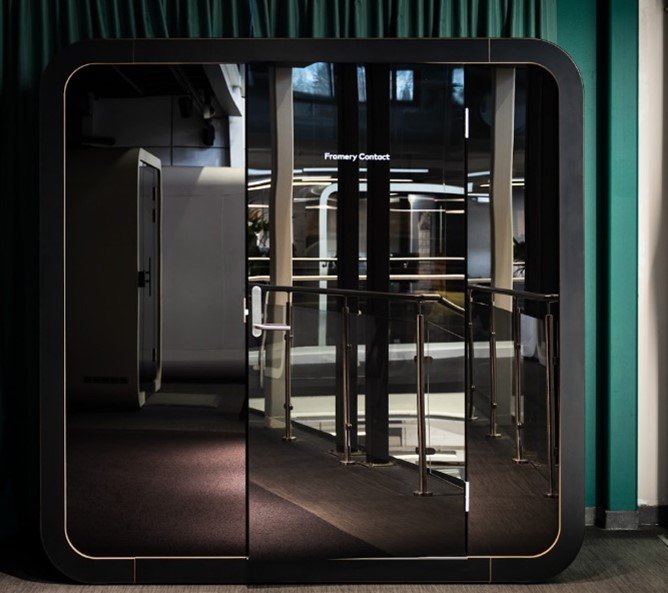Exploring Post-Neocon perspectives | Part ii
Welcome to Part 2 of our two-part post Neocon blog series on the ever-evolving world of workplace design and furniture. We wanted to bring you more insights since our team endured rain, gale-force winds, and walked over 155,000 steps combined to experience it all (and so you didn't have to).
In Part 1, we discussed the need for flexibility, collaboration, and reconfigurable furniture in today's fast-paced work environments, and we introduced the innovative Morse Table System by NaughtOne and the Team Cart by Global Furniture Group as solutions to seamlessly transition between different work modes.
In our previous post, the most prominent insights highlighted were as follows:
COLLABORATIVE AND FLEXIBLE FURNITURE FOR CROSS-GENERATIONAL SPACES
MOBILITY AND RECONFIGURABLE FURNITURE IS ESSENTIAL
GREEN IS KING- SUSTAINABILITY IS EVERYWHERE
SOCIAL + TECHNOLOGY= A WINNING COMBINATION
As organizations increasingly prioritize sustainability and environmental consciousness, as seen at NeoCon and Design Days, furniture design is aligning with these principles to create more eco-friendly and responsible workspaces. Additionally, the intersection of social dynamics and technology integration in the design of contemporary office furniture was highlighted by the one and only, Framery. With the rise of remote work and virtual collaboration, the way we interact with our colleagues and utilize technology has transformed. Furniture designers are harnessing the potential of this winning combination to enhance communication, productivity, and overall workplace experience.
Green is King - Sustainability is Everywhere
Sustainability is becoming a driving force in furniture design, with manufacturers and designers incorporating eco-friendly materials into their products. NaughtOne has consistently strived to make a positive impact on the world. They have been at the forefront of environmental certifications, designing, and manufacturing sustainable products. A great example of NaughtOne’s product line is the Pippin chair. Designed by a talented British Furniture designer, Lucy Kurrein. The Pippin chair gained recognition and exposure in the NaughtOne showroom at the Fulton Market Design Days.
Pippin was created with longevity in mind and a focus on the end of its lifecycle. Every component was meticulously designed to facilitate easy disassembly when its lifespan is complete. Pippin comes with a unique feature—a tailored cover that can be zipped on and off, giving the chair its sophisticated charm. This removable cover not only allows for easy replacement in the event of damage or stains but also enables customization options to suit different styles. In addition, the construction of the chair is entirely free from glues and staples, ensuring easy disassembly and facilitating proper recycling at the end of its lifecycle. NaughtOne's commitment to sustainability is evident in the thoughtful design of Pippin and according to its Product Sustainability Statement 89.8% is recyclable content embodying their dedication to creating products that are both environmentally responsible and aesthetically appealing.
SOCIAL + TECHNOLOGY= A WINNING COMBINATION
As mentioned before, hybrid work is not going anywhere, it is here to stay and with the powerful combination of social dynamics and technology in the modern workplace Framery presented an innovative product at Neocon offering visitors to experience it in person. With the increasing integration of digital tools and collaborative platforms, Framery Contact by Framery is disrupting how technology works to connect people in offices on opposite sides of the country, or even the other side of the world.
Framery Contact is a virtual meeting pod that comes closer to recreating the experience of a real face-to-face conversation than any other technology on the market. The pod is designed to isolate visual and acoustical elements enhancing the sense of being in a shared space with the person on the screen. Our team tried it out firsthand and it’s no exaggeration to say that we were blown away. It was as if the person on the screen (which we couldn’t detect where it began and ended) was sitting in the same booth with us. According to Framery’s research, a single flight between London and New York produces 1.7 tons of carbon dioxide whereas the total emissions from manufacturing, five years of use, and recycling a Framery Contact pod is only 1.4 tons. This innovation is convenient, an absolute perfect combination of social and technology integration with a sustainable aspect to it as well.
From smart furniture that integrates with smart devices to immersive meeting spaces that foster engagement, the insights highlights are shaping the future of workspaces. The future workplace is here, and it's transforming the way we work, collaborate, and thrive.




